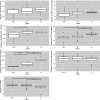Decreasing Plasma Fibrinogen Levels in the Intensive Care Unit Are Associated with High Mortality Rates In Patients With Sepsis-Induced Coagulopathy
- PMID: 35549920
- PMCID: PMC9112680
- DOI: 10.1177/10760296221101386
Decreasing Plasma Fibrinogen Levels in the Intensive Care Unit Are Associated with High Mortality Rates In Patients With Sepsis-Induced Coagulopathy
Abstract
Plasma fibrinogen levels increase in response to infection, but they could also decrease due to degradation as in severe coagulopathy. We evaluated 60 septic patients with their CRP levels over 5.00 mg/dL. The patients were classified into three groups based on the ratio of the maximum or minimum fibrinogen concentration within day 3 to the initial concentration on day 0: down-, flat, and uptrend groups (n = 15, 30, and 15, respectively). Both down- and flat trend groups showed reduced inflammatory markers on day 3, and the degree of platelet loss (103/μL) and the mortality rate (%) were more remarkable in the downtrend group ( - 108 vs - 42 [p = 0.026] and 46.7 vs 10.0 [p = 0.027]). On day 0, in total 12 and 9 patients were diagnosed with non-overt DIC in the down- and uptrend groups, of which 5 (41.7%) and 1 (11.1%) died within 28 days after admission. In conclusion, decreasing fibrinogen levels in the ICU are associated with high mortality in patients with sepsis followed by decreasing platelet counts, even when they are diagnosed with non-overt DIC.
Keywords: SOFA score; fibrinogen; mortality; sepsis; sepsis-induced coagulopathy.
Conflict of interest statement
Figures



Similar articles
-
[Study on the value of prothrombin time for predicting the severity and prognosis of septic patients].Zhonghua Wei Zhong Bing Ji Jiu Yi Xue. 2022 Jul;34(7):682-688. doi: 10.3760/cma.j.cn121430-20210614-00876. Zhonghua Wei Zhong Bing Ji Jiu Yi Xue. 2022. PMID: 36100403 Chinese.
-
Description of compensated and uncompensated disseminated intravascular coagulation (DIC) responses (non-overt and overt DIC) in baboon models of intravenous and intraperitoneal Escherichia coli sepsis and in the human model of endotoxemia: toward a better definition of DIC.Crit Care Med. 2000 Sep;28(9 Suppl):S12-9. doi: 10.1097/00003246-200009001-00004. Crit Care Med. 2000. PMID: 11007191
-
Combination of thrombin-antithrombin complex, plasminogen activator inhibitor-1, and protein C activity for early identification of severe coagulopathy in initial phase of sepsis: a prospective observational study.Crit Care. 2014 Jan 13;18(1):R13. doi: 10.1186/cc13190. Crit Care. 2014. PMID: 24410881 Free PMC article.
-
[A novel molecular marker for thrombus formation and life prognosis--clinical usefulness of measurement of soluble fibrin monomer-fibrinogen complex (SF)].Rinsho Byori. 2004 Apr;52(4):355-61. Rinsho Byori. 2004. PMID: 15164605 Review. Japanese.
-
Coagulopathy of sepsis.Thromb Haemost. 2004 Feb;91(2):213-24. doi: 10.1160/TH03-03-0182. Thromb Haemost. 2004. PMID: 14961146 Review.
Cited by
-
Risk Factors of Sepsis-Associated Thrombocytopenia among Patients with Sepsis Induced Coagulopathy.Clin Appl Thromb Hemost. 2024 Jan-Dec;30:10760296241283166. doi: 10.1177/10760296241283166. Clin Appl Thromb Hemost. 2024. PMID: 39279317 Free PMC article.
-
Fibrinogen contribution to clot strength in patients with sepsis and hematologic malignancies and thrombocytopenia-a prospective, single-center, analytical, cross-sectional study.Res Pract Thromb Haemost. 2024 Mar 1;8(2):102362. doi: 10.1016/j.rpth.2024.102362. eCollection 2024 Feb. Res Pract Thromb Haemost. 2024. PMID: 38666064 Free PMC article.
-
Comparison of the prognostic value of four different critical illness scores in patients with sepsis-induced coagulopathy.Open Life Sci. 2023 Aug 9;18(1):20220659. doi: 10.1515/biol-2022-0659. eCollection 2023. Open Life Sci. 2023. PMID: 37588996 Free PMC article.
-
Markers of Hemophagocytic Lymphohistiocytosis Are Associated with Mortality in Critically Ill Patients.J Clin Med. 2025 Mar 14;14(6):1970. doi: 10.3390/jcm14061970. J Clin Med. 2025. PMID: 40142777 Free PMC article.
-
Mitochondria at the Heart of Sepsis: Mechanisms, Metabolism, and Sex Differences.Int J Mol Sci. 2025 Apr 29;26(9):4211. doi: 10.3390/ijms26094211. Int J Mol Sci. 2025. PMID: 40362448 Free PMC article. Review.
References
-
- Kobayashi N, Maekawa T, Takada M, et al. Criteria for diagnosis of DIC based on the analysis of clinical and laboratory findings in 345 DIC patients collected by the Research Committee on DIC in Japan. Bibl Haematol. 1983;(49):265-275. - PubMed
-
- Taylor FB, Toh CH, Hoots WK, et al. Towards definition, clinical and laboratory criteria, and a scoring system for disseminated intravascular coagulation. Thromb Haemost. 2001;86(5):1327-1330. - PubMed
-
- Gando S, Iba T, Eguchi Y, et al. A multicenter, prospective validation of disseminated intravascular coagulation diagnostic criteria for critically ill patients: comparing current criteria. Crit Care Med. 2006;34(3):625-631. - PubMed
MeSH terms
Substances
LinkOut - more resources
Full Text Sources
Medical
Research Materials
Miscellaneous

